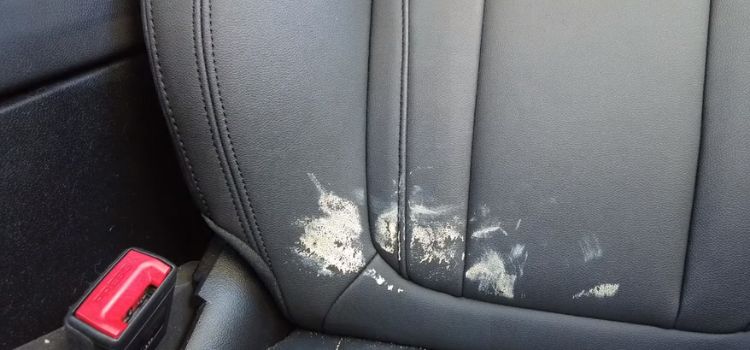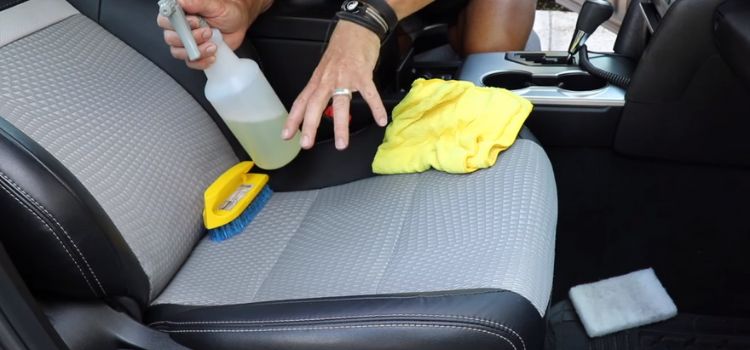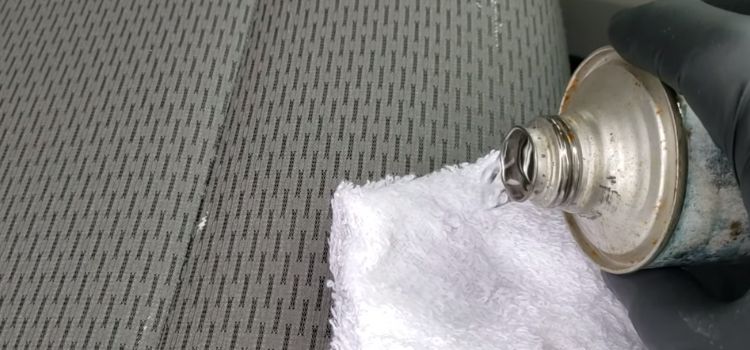As an Amazon Associate, I earn from qualifying purchases
Whether you’ve spilled paint on your car seat while painting or accidentally gotten a glob of paint on your car seat while doing other projects, removing paint from car seats is no easy task. However, it is possible to get the paint out with the right approach and some elbow grease. This post will discuss the best way to get paint out of car seats and the products and tools needed to do the job. Let’s get started!
Identify the Type of Paint

Before attempting to remove paint from your car seat, you must identify the type of paint you are dealing with. There are many different types of paint, each requiring a different removal approach. Knowing what kind of paint you are dealing with is the first step to properly and safely removing it from your car seat. To identify the type of paint, look for a few key characteristics.
If the paint is water-soluble, it will be easy to remove with a mild detergent and some water. If the paint is oil-based, you must use a solvent to dissolve the paint. Finally, if the paint is latex or enamel-based, you can use a combination of solvents and detergents to loosen and remove the paint.
Prepare the Area
Once you have identified the type of paint, the next step is to prepare the area where you will be removing the paint. Before beginning, make sure to put on a pair of rubber gloves and safety goggles to protect yourself. Next, you must cover the area with a drop cloth or newspaper to prevent spills from damaging your car seat. Lastly, using solvents to remove the paint, you must ensure the area is well-ventilated. After the area is prepped, you can begin the paint removal process.
Test Mild Cleaning Solutions

To identify the type of paint and prepare the area before beginning the paint removal process. To determine the type of paint, look for a few key characteristics. If the paint is water-soluble, it will be easy to remove with a mild detergent and some water. If the paint is oil-based, you must use a solvent to dissolve the paint.
Finally, if the paint is latex or enamel-based, you can use a combination of solvents and detergents to loosen and remove the paint. Once you have identified the type of paint, the next step is to prepare the area where you will be removing the paint. Before beginning, make sure to put on a pair of rubber gloves and safety goggles to protect yourself. Next, you must cover the area with a drop cloth or newspaper to prevent spills from damaging your car seat.
Lastly, using solvents to remove the paint, you must ensure the area is well-ventilated. Once the area is prepped, you can begin the paint removal process. Make sure to test mild cleaning solutions on a small paint area first. This will help you determine which products will work best and what precautions to take to avoid damage to the car seat. This will also help you decide which products and techniques will work best for the paint you are dealing with. If you use the wrong product or strategy, you may damage the seat or worsen the problem. Follow the instructions carefully, and be sure always to practice safety first.
Use a Solvent-Based Cleaner

When removing paint from car seats. Solvents are effective for removing paint and other difficult stains. Start by removing any excess dirt or dust from the surface. Then, use a dry cloth to remove any remaining dirt. Then, cover the area with a drop cloth or newspaper to prevent spills from damaging your car seat. Once the area is prepped, you can begin the paint removal process.
Make sure to test mild cleaning solutions on a small paint area first. This will help you determine which products and techniques will work best for the paint you are dealing with. If you use the wrong product or strategy, you may damage the seat or worsen the problem. Wear protective gear like gloves, goggles, and a face mask to protect yourself from the fumes.
And be sure to work in a well-ventilated area. To make the process easier, use a bristle brush to help evenly work the solvent into the stain. This will help break down the paint and make it easier to remove. Follow the instructions carefully, and be sure always to practice safety first.
Use a Paint Scraper
To help remove stubborn and dried paint from a variety of surfaces. Before you begin, you must ensure the surface is clean and free of dust or dirt. This will ensure the scraper can get underneath the paint and work effectively. Additionally, test mild cleaning solutions on a small paint area first. This will help you determine which products and techniques will work best for the paint you are dealing with.
If you use the wrong product or strategy, you may damage the seat or worsen the problem. Wear protective gear like gloves, goggles, and a face mask to protect yourself from the fumes. And be sure to work in a well-ventilated area. To make the process easier, use a bristle brush to help evenly work the solvent into the stain. This will help break down the paint and make it easier to remove.
After the stain has been performed, use a paint scraper to scrape away the paint carefully. Be sure to use the scraper gently and with care. If you need help using the scraper, consult the user manual for further instructions. Follow the instructions carefully, and be sure always to practice safety first.
Apply a Stain Remover
To remove any paint or other tough stains. Wear protective gear, including gloves, goggles, and a face mask, to protect yourself from the fumes and debris. It is also essential to ensure you work in a well-ventilated area before beginning the process. Before you start, have all the necessary supplies, such as a brush, a scraper, and a solvent. Start using a bristle brush to brush the solvent into the stain. This will help break down the paint and make removing it easier.
After the process is completed, use a paint scraper to scrape away the paint carefully. Be sure to use the scraper gently and with care. If you need help using the scraper, consult the user manual for further instructions. Follow the instructions carefully, and be sure always to practice safety first. Once the paint has been completely removed, cleaning the area thoroughly with a damp cloth is essential to remove all the solvent residue. After cleaning the area, apply a sealant to protect the surface from future damage.
Rinse and Dry the Area
After removing the paint, it is essential to rinse and dry the area to remove any remaining solvent residue. This will help to ensure that the paint will not return. To flush the area:
Use a garden hose or a pressure washer.
Use a gentle stream of water to ensure you do not damage the surface.
After the area is rinsed, use a soft cloth to dry the area. Once the area is arid, it is essential to apply a sealant.
This will help to protect the surface from future damage and ensure that the paint will not return. If you are still determining what kind of sealant to use, consult a professional for further guidance. Always practice safety first and follow the instructions carefully when applying the adhesive.
Conclusion
Getting paint out of car seats can be difficult and time-consuming, but it is possible. Act quickly and use the proper techniques to avoid further damage, starting by scraping off as much of the paint as possible and then using a combination of solvents, vacuuming, and scrubbing to remove the rest. If you still need help, you can also hire a professional to do the job. Always take extra care when working with car seats, as they are delicate and easily damaged.
As an Amazon Associate, I earn from qualifying purchases
Leave a Reply